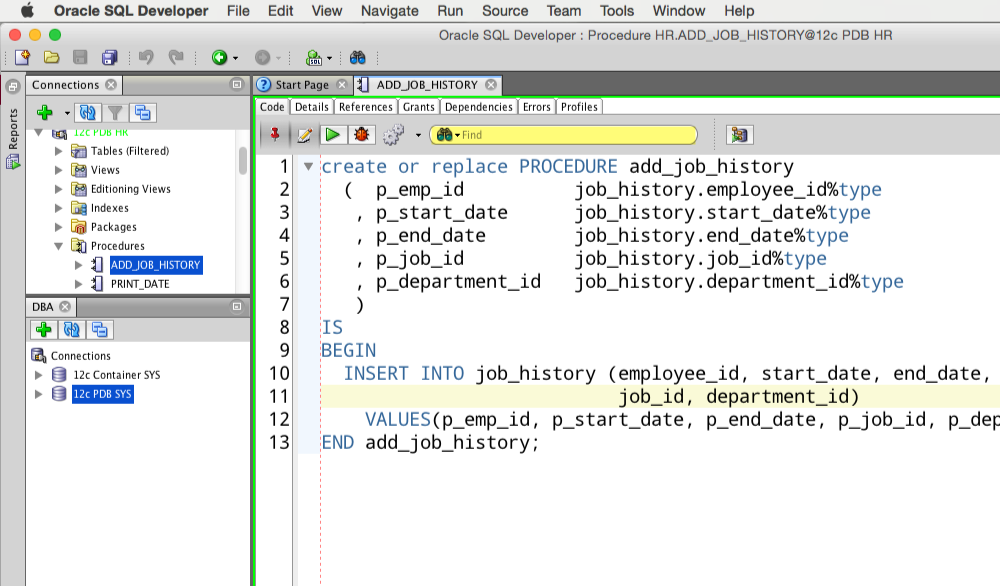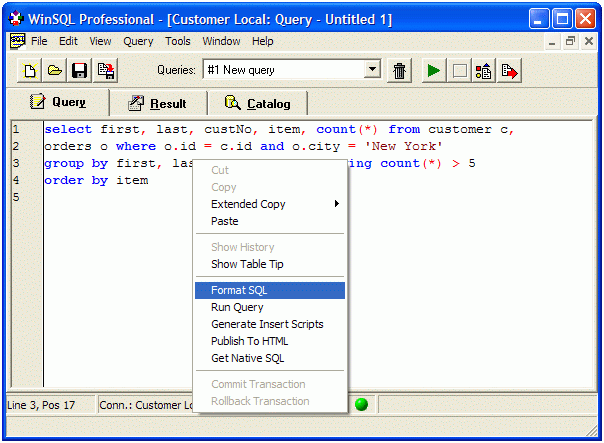

- SQL DEVELOPER CODE FORMATTER SOFTWARE
- SQL DEVELOPER CODE FORMATTER DOWNLOAD
- SQL DEVELOPER CODE FORMATTER FREE
The prominent features of this tool are that it creates completely sharable and customized formatting, a library of code snippets is provided, we can refactor the SQL code, analysis of code can be dome very comprehensively, tab history and coloring and code completion of advanced IntelliSense-style.
SQL DEVELOPER CODE FORMATTER DOWNLOAD
Code Beautify – This formatter tool comes with the provision to download the formatted code and we can even remove the comments and minify the SQL code by using this tool available online.Let us have a look at some of them here listing the specialties of each of them and links to access them. There are many online formatting tools available that can beautify and indent your PL/ SQL source code. We can even pass the files which include the PL/ SQL source code instead of the raw queries, procedures, functions, etc.This feature is mainly used for security reasons. Some of the formatters even provide the feature which can obfuscate the source code which scrambles the code and makes it difficult for another person to encode it.UNICODE, ASCII, and European ASCII encoding is followed by the output.Tab column positions for arbitrary input can be specified in a formatter. We can customize the spacing and step distance while performing the indentation with the help of a formatter.Even if you don’t have the oracle connection, you can still do a complete check over your syntax of the source code with the help of a formatter.Execution is not affected after formatting the code which means the code executes in the same manner as it was doing before formatting.The general features provided by each of the formatting tools of PL/ SQL includes the following specified points –
SQL DEVELOPER CODE FORMATTER SOFTWARE
Web development, programming languages, Software testing & others Features of PL/ SQL Formatters
SQL DEVELOPER CODE FORMATTER FREE
operator ( string) – Operator to test.Start Your Free Software Development Course.include_children ( boolean) – Whether or not to include children for hierarchical taxonomies.terms ( int/string/array) – Taxonomy term(s).Possible values are ‘term_id’, ‘name’, ‘slug’ or ‘term_taxonomy_id’. field ( string) – Select taxonomy term by.Do not use with a single inner taxonomy array. relation ( string) – The logical relationship between each inner taxonomy array when there is more than one.

tax_query ( array) – use taxonomy parameters (available since version 3.1).( Deprecated since version 3.1 in favor of ‘ tax_query‘). Like so… have_posts() ) ( string) – use taxonomy slug. If you have multiple queries, you need to perform multiple loops. Top ↑ Standard Loop (Alternate) have_posts() ) : ?> have_posts() ) :

'' Įsc_html_e( 'Sorry, no posts matched your criteria.' ) Note: Ticket #18408 For querying posts in the admin, consider using get_posts() as wp_reset_postdata() might not behave as expected.Įcho ''. Note: If you use the_post() with your query, you need to run wp_reset_postdata() afterwards to have template tags use the main query’s current post again. These are the functions you should use when writing a theme file that needs a loop. In each iteration, the_post(), which calls $wp_query->the_post() is called, setting up internal variables within $wp_query and the global $post variable (which the Template Tags rely on), as above. This will iterate around as long as there are posts to show. If there are, a while loop is begun, using have_posts() as the condition. To begin with, have_posts(), which calls $wp_query->have_posts(), is called to see if there are any posts to show. WP_Query provides numerous functions for common tasks within The Loop. This is the more common scenario to plugin writers (the second normally applies to theme writers). The $is_* properties are designed to hold this information: use the Conditional Tags to interact here. The first is to find out what type of request WordPress is currently dealing with.

There are two main scenarios you might want to use WP_Query in. There are a whole bunch of functions that you can call from anywhere that will enable you to get the information you need. Most of the time you can find the information you want without actually dealing with the class internals and global variables.


 0 kommentar(er)
0 kommentar(er)
